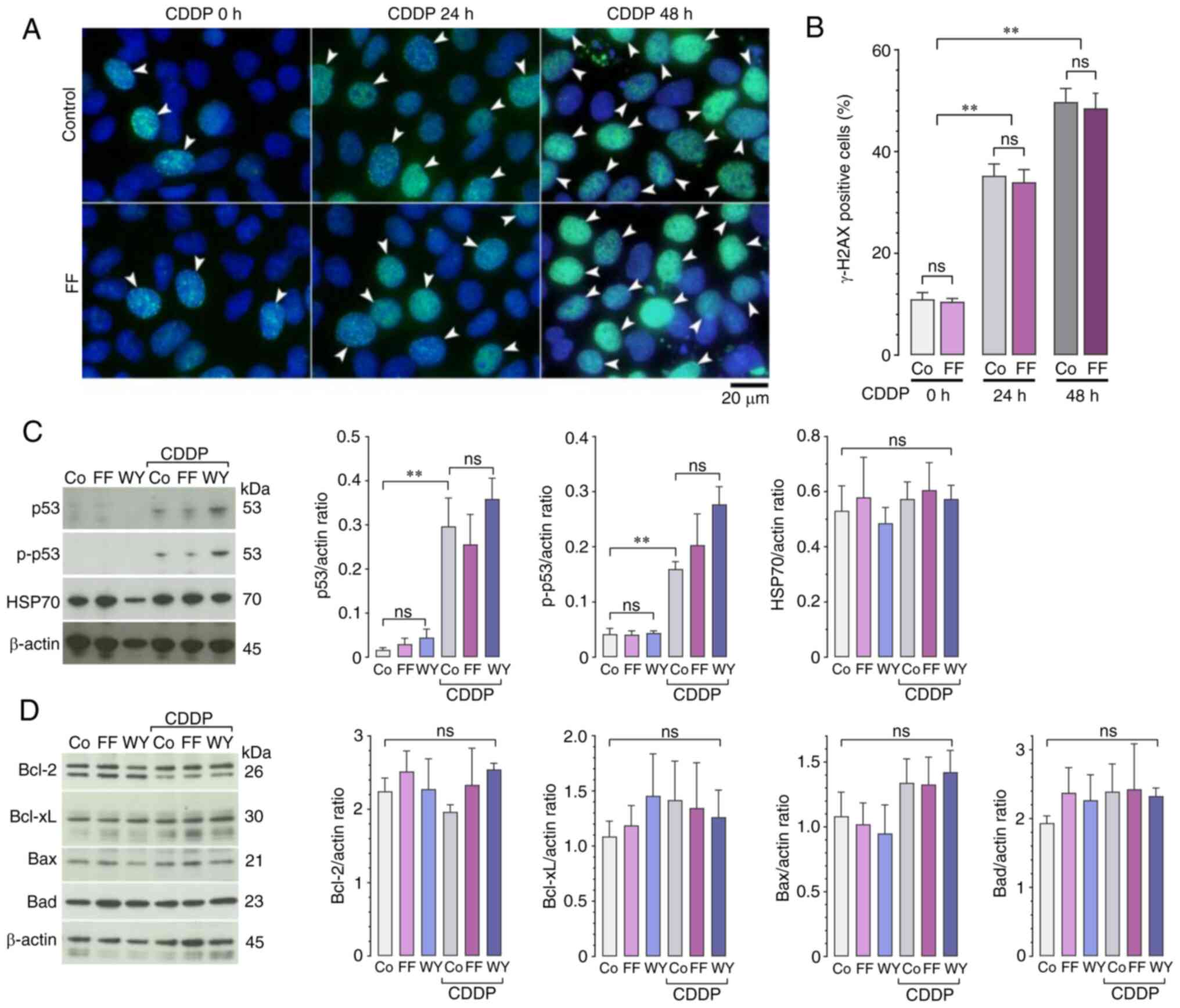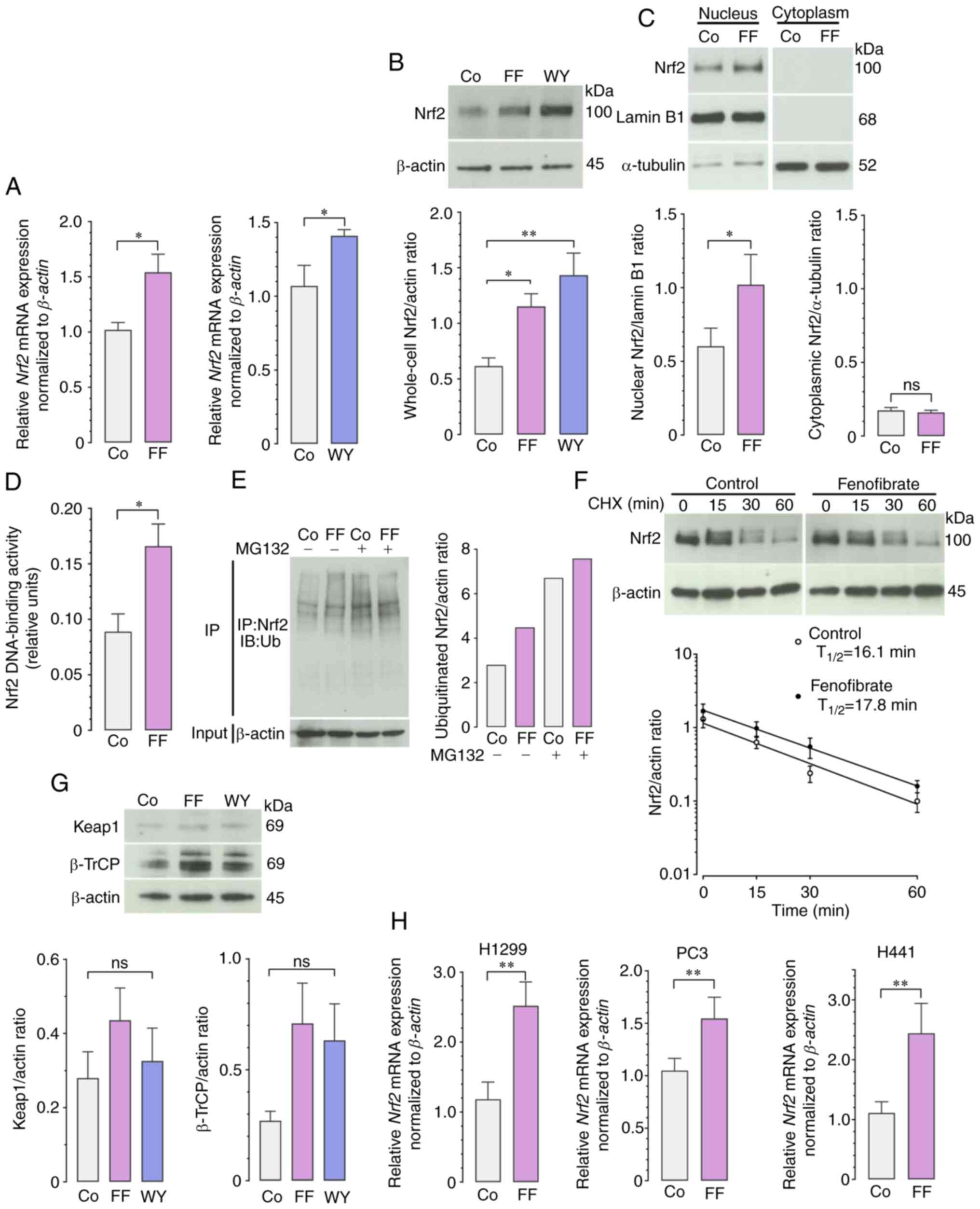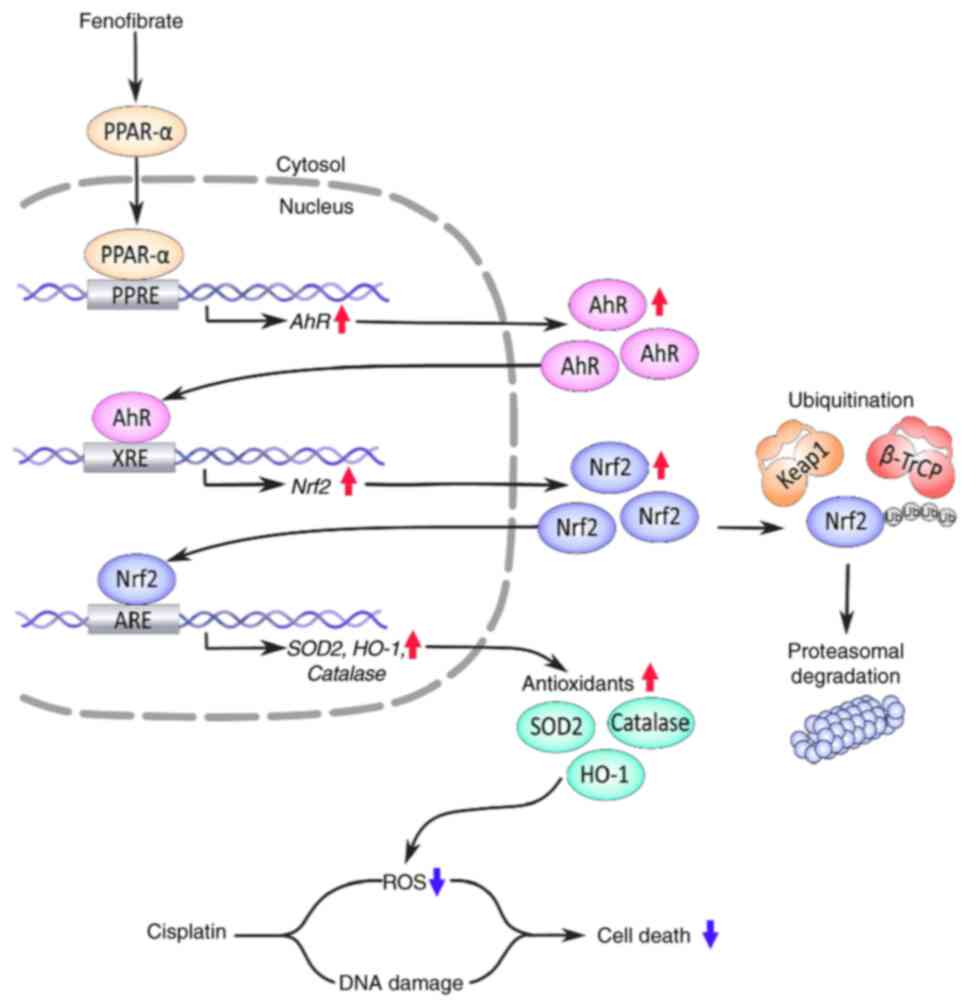|
1
|
Patsouris D, Mandard S, Voshol PJ, Escher
P, Tan NS, Havekes LM, Koenig W, März W, Tafuri S, Wahli W, et al:
PPARalpha governs glycerol metabolism. J Clin Invest. 114:94–103.
2004. View Article : Google Scholar : PubMed/NCBI
|
|
2
|
Koltai T: Fenofibrate in cancer:
Mechanisms involved in anticancer activity. F1000Res. 4:552015.
View Article : Google Scholar
|
|
3
|
Abdel Magid AM, Abbassi MM, Iskander EEM,
Mohamady O and Farid SF: Randomized comparative efficacy and safety
study of intermittent simvastatin versus fenofibrate in
hemodialysis. J Comp Eff Res. 6:413–424. 2017. View Article : Google Scholar : PubMed/NCBI
|
|
4
|
Noonan JE, Jenkins AJ, Ma JX, Keech AC,
Wang JJ and Lamoureux EL: An update on the molecular actions of
fenofibrate and its clinical effects on diabetic retinopathy and
other microvascular end points in patients with diabetes. Diabetes.
62:3968–3975. 2013. View Article : Google Scholar : PubMed/NCBI
|
|
5
|
Lian X, Wang G, Zhou H, Zheng Z, Fu Y and
Cai L: Anticancer roperties of fenofibrate: A repurposing use. J
Cancer. 9:1527–1537. 2018. View Article : Google Scholar : PubMed/NCBI
|
|
6
|
Vlase L, Popa A, Muntean D and Leucuta SE:
Pharmacokinetics and comparative bioavailability of two fenofibrate
capsule formulations in healthy volunteers. Arzneimittelforschung.
60:560–563. 2010.PubMed/NCBI
|
|
7
|
Davies SP, Mycroft-West CJ, Pagani I, Hill
HJ, Chen YH, Karlsson R, Bagdonaite I, Guimond SE, Stamataki Z, De
Lima MA, et al: The hyperlipidaemic drug fenofibrate significantly
reduces infection by SARS-CoV-2 in cell culture models. Front
Pharmacol. 12:6604902021. View Article : Google Scholar : PubMed/NCBI
|
|
8
|
Luty M, Piwowarczyk K, Łabędź-Masłowska A,
Wróbel T, Szczygieł M, Catapano J, Drabik G, Ryszawy D,
Kędracka-Krok S, Madeja Z, et al: Fenofibrate augments the
sensitivity of drug-resistant prostate cancer cells to docetaxel.
Cancers (Basel). 11:772019. View Article : Google Scholar : PubMed/NCBI
|
|
9
|
Balakumar P, Sambathkumar R, Mahadevan N,
Muhsinah AB, Alsayari A, Venkateswaramurthy N and Dhanaraj SA:
Molecular targets of fenofibrate in the cardiovascular-renal axis:
A unifying perspective of its pleiotropic benefits. Pharmacol Res.
144:132–141. 2019. View Article : Google Scholar : PubMed/NCBI
|
|
10
|
Li J, Wang P, Chen Z, Yu S and Xu H:
Fenofibrate ameliorates oxidative stress-induced retinal
microvascular dysfunction in diabetic rats. Curr Eye Res.
43:1395–1403. 2018. View Article : Google Scholar : PubMed/NCBI
|
|
11
|
Sekulic-Jablanovic M, Petkovic V, Wright
MB, Kucharava K, Huerzeler N, Levano S, Brand Y, Leitmeyer K, Glutz
A, Bausch A and Bodmer D: Effects of peroxisome proliferator
activated receptors (PPAR)-γ and -α agonists on cochlear protection
from oxidative stress. PLOS One. 12:e01885962017. View Article : Google Scholar : PubMed/NCBI
|
|
12
|
Hsu YJ, Lin CW, Cho SL, Yang WS, Yang CM
and Yang CH: Protective effect of fenofibrate on oxidative
stress-induced apoptosis in retinal-choroidal vascular endothelial
cells: Implication for diabetic retinopathy treatment. Antioxidants
(Basel). 9:7122020. View Article : Google Scholar : PubMed/NCBI
|
|
13
|
Cortes-Lopez F, Sanchez-Mendoza A,
Centurion D, Cervantes-Perez LG, Castrejon-Tellez V, Del
Valle-Mondragon L, Soria-Castro E, Ramirez V, Sanchez-Lopez A,
Pastelin-Hernandez G, et al: Fenofibrate protects cardiomyocytes
from hypoxia/reperfusion- and high glucose-induced detrimental
effects. PPAR Res. 2021:88953762021. View Article : Google Scholar : PubMed/NCBI
|
|
14
|
Thongnuanjan P and Soodvilai S,
Chatsudthipong V and Soodvilai S: Fenofibrate reduces
cisplatin-induced apoptosis of renal proximal tubular cells via
inhibition of JNK and p38 pathways. J Toxicol Sci. 41:339–349.
2016. View Article : Google Scholar : PubMed/NCBI
|
|
15
|
Kim SJ, Park C, Lee JN and Park R:
Protective roles of fenofibrate against cisplatin-induced
ototoxicity by the rescue of peroxisomal and mitochondrial
dysfunction. Toxicol Appl Pharmacol. 353:43–54. 2018. View Article : Google Scholar : PubMed/NCBI
|
|
16
|
Dasari S and Tchounwou PB: Cisplatin in
cancer therapy: Molecular mechanisms of action. Eur J Pharmacol.
740:364–378. 2014. View Article : Google Scholar : PubMed/NCBI
|
|
17
|
Livak KJ and Schmittgen TD: Analysis of
relative gene expression data using real-time quantitative PCR and
the 2(−Delta Delta C(T)) method. Methods. 25:402–408. 2001.
View Article : Google Scholar : PubMed/NCBI
|
|
18
|
Desager JP, Horsmans Y, Vandenplas C and
Harvengt C: Pharmacodynamic activity of lipoprotein lipase and
hepatic lipase, and pharmacokinetic parameters measured in
normolipidaemic subjects receiving ciprofibrate (100 or 200 mg/day)
or micronised fenofibrate (200 mg/day) therapy for 23 days.
Atherosclerosis. 124 (Suppl):S65–S73. 1996. View Article : Google Scholar : PubMed/NCBI
|
|
19
|
Ivashkevich A, Redon CE, Nakamura AJ,
Martin RF and Martin OA: Use of the γ-H2AX assay to monitor DNA
damage and repair in translational cancer research. Cancer Lett.
327:123–133. 2012. View Article : Google Scholar : PubMed/NCBI
|
|
20
|
Yip KW and Reed JC: Bcl-2 family proteins
and cancer. Oncogene. 27:6398–6406. 2008. View Article : Google Scholar : PubMed/NCBI
|
|
21
|
Endo H, Yano M, Okumura Y and Kido H:
Ibuprofen enhances the anticancer activity of cisplatin in lung
cancer cells by inhibiting the heat shock protein 70. Cell Death
Dis. 5:e10272014. View Article : Google Scholar : PubMed/NCBI
|
|
22
|
Berndtsson M, Hägg M, Panaretakis T,
Havelka AM, Shoshan MC and Linder S: Acute apoptosis by cisplatin
requires induction of reactive oxygen species but is not associated
with damage to nuclear DNA. Int J Cancer. 120:175–180. 2007.
View Article : Google Scholar : PubMed/NCBI
|
|
23
|
Kikuchi R, Iwai Y, Tsuji T, Watanabe Y,
Koyama N, Yamaguchi K, Nakamura H and Aoshiba K: Hypercapnic tumor
microenvironment confers chemoresistance to lung cancer cells by
reprogramming mitochondrial metabolism in vitro. Free Radic Biol
Med. 134:200–214. 2019. View Article : Google Scholar : PubMed/NCBI
|
|
24
|
Fujii J, Homma T and Osaki T: Superoxide
radicals in the execution of cell death. Antioxidants(Basel).
11:5012022. View Article : Google Scholar : PubMed/NCBI
|
|
25
|
Shaw P and Chattopadhyay A: Nrf2-ARE
signaling in cellular protection: Mechanism of action and the
regulatory mechanisms. J Cell Physiol. 235:3119–3130. 2020.
View Article : Google Scholar : PubMed/NCBI
|
|
26
|
Lee C: Collaborative power of Nrf2 and
PPARγ activators against metabolic and drug-Induced oxidative
injury. Oxid Med Cell Longev. 2017:13781752017. View Article : Google Scholar : PubMed/NCBI
|
|
27
|
Kobayashi A, Kang MI, Okawa H, Ohtsuji M,
Zenke Y, Chiba T, Igarashi K and Yamamoto M: Oxidative stress
sensor Keap1 functions as an adaptor for Cul3-based E3 ligase to
regulate proteasomal degradation of Nrf2. Mol Cell Biol.
24:7130–7139. 2004. View Article : Google Scholar : PubMed/NCBI
|
|
28
|
Taguchi K and Yamamoto M: The KEAP1-NRF2
system in cancer. Front Oncol. 7:852017. View Article : Google Scholar : PubMed/NCBI
|
|
29
|
Probst BL, McCauley L, Trevino I, Wigley
WC and Ferguson DA: Cancer cell growth is differentially affected
by constitutive activation of NRF2 by KEAP1 deletion and
pharmacological activation of NRF2 by the synthetic triterpenoid,
RTA 405. PLoS One. 10:e01352572015. View Article : Google Scholar : PubMed/NCBI
|
|
30
|
Wang R, An J, Ji F, Jiao H, Sun H and Zhou
D: Hypermethylation of the Keap1 gene in human lung cancer cell
lines and lung cancer tissues. Biochem Biophys Res Commun.
373:151–154. 2008. View Article : Google Scholar : PubMed/NCBI
|
|
31
|
Miao W, Hu L, Scrivens PJ and Batist G:
Transcriptional regulation of NF-E2 p45-related factor (NRF2)
expression by the aryl hydrocarbon receptor-xenobiotic response
element signaling pathway: Direct cross-talk between phase I and II
drug-metabolizing enzymes. J Biol Chem. 280:20340–20348. 2005.
View Article : Google Scholar : PubMed/NCBI
|
|
32
|
Larigot L, Juricek L, Dairou J and Coumoul
X: AhR signaling pathways and regulatory functions. Biochim Open.
7:1–9. 2018. View Article : Google Scholar : PubMed/NCBI
|
|
33
|
Villard PH, Caverni S, Baanannou A, Khalil
A, Martin PG, Penel C, Pineau T, Seree E and Barra Y: PPARalpha
transcriptionally induces AhR expression in Caco-2, but represses
AhR pro-inflammatory effects. Biochem Biophys Res Commun.
364:896–901. 2007. View Article : Google Scholar : PubMed/NCBI
|
|
34
|
Coelho NR, Pimpão AB, Correia MJ,
Rodrigues TC, Monteiro EC, Morello J and Pereira SA:
Pharmacological blockage of the AHR-CYP1A1 axis: A call for in vivo
evidence. J Mol Med (Berl). 100:215–243. 2022. View Article : Google Scholar : PubMed/NCBI
|
|
35
|
Terashima J, Habano W, Gamou T and Ozawa
S: Induction of CYP1 family members under low-glucose conditions
requires AhR expression and occurs through the nuclear
translocation of AhR. Drug Metab Pharmacokinet. 26:577–583. 2011.
View Article : Google Scholar : PubMed/NCBI
|
|
36
|
Majeed Y, Upadhyay R, Alhousseiny S, Taha
T, Musthak A, Shaheen Y, Jameel M, Triggle CR and Ding H: Potent
and PPARα-independent anti-proliferative action of the
hypolipidemic drug fenofibrate in VEGF-dependent angiosarcomas in
vitro. Sci Rep. 9:63162013. View Article : Google Scholar
|
|
37
|
Kikuchi R, Maeda Y, Tsuji T, Yamaguchi K,
Abe S, Nakamura H and Aoshiba K: Fenofibrate inhibits TGF-β-induced
myofibroblast differentiation and activation in human lung
fibroblasts in vitro. FEBS Open Bio. 11:2340–2349. 2021.(Epub ahead
of print). View Article : Google Scholar : PubMed/NCBI
|
|
38
|
Raghunath A, Sundarraj K, Nagarajan R,
Arfuso F, Bian J, Kumar AP, Sethi G and Perumal E: Antioxidant
response elements: Discovery, classes, regulation and potential
applications. Redox Biol. 17:297–314. 2018. View Article : Google Scholar : PubMed/NCBI
|
|
39
|
Park JS, Kang DH, Lee DH and Bae SH:
Fenofibrate activates Nrf2 through p62-dependent Keap1 degradation.
Biochem Biophys Res Commun. 465:542–547. 2015. View Article : Google Scholar : PubMed/NCBI
|
|
40
|
Kim T and Yang Q:
Peroxisome-proliferator-activated receptors regulate redox
signaling in the cardiovascular system. World J Cardiol. 5:164–174.
2013. View Article : Google Scholar : PubMed/NCBI
|
|
41
|
Kim YH, Yoo HY, Chang MS, Jung G and Rho
HM: C/EBP alpha is a major activator for the transcription of rat
Cu/Zn superoxide dismutase gene in liver cell. FEBS Lett.
401:267–270. 1997. View Article : Google Scholar : PubMed/NCBI
|
|
42
|
Ding G, Fu M, Qin Q, Lewis W, Kim HW,
Fukai T, Bacanamwo M, Chen YE, Schneider MD, Mangelsdorf DJ, et al:
Cardiac peroxisome proliferator-activated receptor gamma is
essential in protecting cardiomyocytes from oxidative damage.
Cardiovasc Res. 76:269–279. 2007. View Article : Google Scholar : PubMed/NCBI
|
|
43
|
Girnun GD, Domann FE, Moore SA and Robbins
ME: Identification of a functional peroxisome
proliferator-activated receptor response element in the rat
catalase promoter. Mol Endocrinol. 16:2793–2801. 2002. View Article : Google Scholar : PubMed/NCBI
|
|
44
|
Shin S, Wakabayashi N, Misra V, Biswal S,
Lee GH, Agoston ES, Yamamoto M and Kensler TW: NRF2 modulates aryl
hydrocarbon receptor signaling: Influence on adipogenesis. Mol Cell
Biol. 27:7188–7197. 2007. View Article : Google Scholar : PubMed/NCBI
|
|
45
|
Ma Q: Role of nrf2 in oxidative stress and
toxicity. Annu Rev Pharmacol Toxicol. 53:401–26. 2013. View Article : Google Scholar : PubMed/NCBI
|
|
46
|
Sun C, Song B, Sheng W, Yu D, Yang T, Geng
F, Fang K, Jiao Y, Zhang J and Zhang S: Fenofibrate attenuates
radiation-induced oxidative damage to the skin through fatty acid
binding protein 4 (FABP4). Front Biosci (Landmark Ed). 27:2142022.
View Article : Google Scholar : PubMed/NCBI
|
|
47
|
Kadian S, Mahadevan N and Balakumar P:
Differential effects of low-dose fenofibrate treatment in diabetic
rats with early onset nephropathy and established nephropathy. Eur
J Pharmacol. 698:388–396. 2013. View Article : Google Scholar : PubMed/NCBI
|
|
48
|
Ibarra-Lara L, Sánchez-Aguilar M,
Sánchez-Mendoza A, Del Valle-Mondragón L, Soria-Castro E,
Carreón-Torres E, Díaz-Díaz E, Vázquez-Meza H, Guarner-Lans V and
Rubio-Ruiz ME: Fenofibrate therapy restores antioxidant protection
and improves myocardial insulin resistance in a rat model of
metabolic syndrome and myocardial ischemia: The role of angiotensin
II. Molecules. 22:312016. View Article : Google Scholar : PubMed/NCBI
|


















